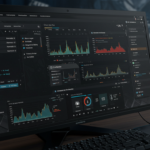Introduction
In today’s digital-first world, content sharing has evolved into a culture of instant access. One of the emerging terms circulating across online communities is livcamrips. This phrase refers to recordings or screen captures of live-streamed cam sessions that are redistributed without authorization. While the idea may sound niche, it touches on broader themes of digital rights, online privacy, and the economics of live entertainment. Understanding livcamrips requires looking beyond the surface, as it intersects with technology, law, and consumer behavior.
The popularity of live-streaming platforms has created a billion-dollar industry where creators broadcast to global audiences. From social interaction to performance art, these platforms thrive on immediacy and exclusivity. However, the rise of livcamrips disrupts this balance by stripping away the live element and redistributing content in unauthorized ways. For users, the appeal may be convenience or cost-saving. For creators, though, the consequences can be significant: revenue loss, breach of trust, and potential harm to personal safety.
Discussing livcamrips is not about glorifying the practice but about examining why it exists and how it affects digital culture. Whether you’re a casual internet user, a creator seeking to protect your work, or simply someone curious about online trends, understanding this phenomenon sheds light on bigger issues such as online piracy, content monetization, and privacy rights. The topic also raises questions about how platforms, creators, and consumers can navigate a space where accessibility and ethics often clash.
The Origins of Livcamrips
Livcamrips stem from the rapid rise of live cam streaming, which became mainstream in the late 2000s as internet speeds improved. Initially, these platforms catered to small communities, offering a sense of connection and exclusivity. Over time, the popularity of live-streaming exploded across different niches, from gaming to lifestyle vlogs and interactive performances. With growth came challenges, particularly in protecting intellectual property. Screen recording tools made it easy for viewers to capture streams, leading to the birth of livcamrips as an underground form of redistribution.
The term itself combines “live cam” with “rips,” emphasizing the act of extracting or recording original live content. While often associated with adult entertainment, the practice can apply to any live-streamed session. For instance, gamers broadcasting a competition may find their streams ripped and uploaded elsewhere without consent. This universality makes livcamrips a critical issue across industries. By understanding its roots, we see how technological accessibility and consumer demand have driven its growth, creating ripple effects in digital economies.
Why Livcamrips Appeal to Viewers
For many viewers, the attraction of livcamrips lies in cost and convenience. Live-streaming platforms often operate on pay-per-view models or subscription-based access. While this structure compensates creators, it can exclude audiences unwilling or unable to pay. Livcamrips, freely available on various file-sharing or discussion boards, bypass those financial barriers. Viewers gain access to otherwise premium content at no cost, making it tempting for those seeking instant gratification without commitment.
Another appeal is permanence. Unlike live shows that vanish once the broadcast ends, livcamrips capture moments that can be revisited indefinitely. For fans who missed a stream, these recordings may seem like a second chance. However, this convenience undermines the very essence of live streaming: real-time connection. Platforms thrive on spontaneity and interactivity, elements lost in rips. This creates tension between what viewers want and what the ecosystem requires to remain sustainable.
Risks and Consequences of Livcamrips
While some users see livcamrips as harmless, the risks extend far beyond casual consumption. For creators, unauthorized distribution directly cuts into revenue streams. Many depend on subscriptions, tips, or paywall-protected content to support themselves. When livcamrips circulate freely, fewer viewers have an incentive to pay, eroding the economic foundation of live-streaming industries. The impact can be especially damaging for independent creators who lack the backing of larger platforms.
There are also personal risks. Livcamrips often strip context, privacy, and consent. A creator who performed for a limited audience may suddenly find their content widely available, leading to reputational harm or safety concerns. Once online, these recordings are difficult to erase. For consumers, engaging with such material can pose risks too. Many sites hosting livcamrips operate in gray or illegal zones, exposing users to malware, scams, or legal repercussions. Thus, what seems like free access can quickly carry hidden costs.
The Legal Landscape
From a legal standpoint, livcamrips occupy contentious territory. Copyright law typically protects original works, and live-streamed content qualifies under this umbrella. Unauthorized recording and redistribution constitute infringement, leaving creators with the right to pursue legal action. However, enforcing these rights is often complex. Livcamrips are shared on platforms that may be hosted abroad or operate anonymously, making accountability difficult.
Governments and platforms have begun responding with stricter measures. For example, the Digital Millennium Copyright Act (DMCA) in the United States allows creators to issue takedown notices for infringing content. Some platforms also use automated tools to detect and remove pirated material. While these tools help, they cannot eliminate the problem entirely. This ongoing battle highlights the tension between technological advancement and the need to protect intellectual property in an increasingly borderless digital world.
Ethical Considerations
Beyond legality, livcamrips raise important ethical questions. At its core, live-streaming is built on trust: creators share their work, and audiences support them through engagement or financial contributions. Consuming livcamrips breaks that trust by exploiting creators’ efforts without compensation. This can foster a culture of entitlement, where users expect free access regardless of the labor involved.
There’s also the matter of consent. Many creators design content specifically for limited audiences. By ripping and redistributing their streams, that consent is disregarded. Ethically, this mirrors larger issues in digital culture, such as the debate over online privacy, respect for intellectual labor, and the balance between access and fairness. By questioning the ethics of livcamrips, both creators and consumers can better understand their roles in shaping a respectful digital environment.
The Role of Technology
Technology both enables and combats livcamrips. On one hand, affordable screen-recording tools, browser extensions, and even mobile apps make capturing live streams effortless. The proliferation of cloud storage and file-sharing platforms ensures that once a rip exists, it can spread rapidly. These innovations have fueled the persistence of livcamrips despite creators’ best efforts.
On the other hand, technology offers solutions. Some platforms now employ watermarking, digital fingerprinting, and real-time monitoring to identify and block unauthorized rips. Advanced AI detection systems can flag suspicious uploads quickly. While no system is perfect, these advancements reflect a growing recognition of the problem. The challenge lies in balancing user experience with protective measures, ensuring that technology empowers both creators and audiences responsibly.
Protecting Creators and Audiences
To address livcamrips, creators and platforms must adopt proactive strategies. For creators, setting clear boundaries, using platform-provided protection tools, and educating audiences about the harms of piracy can make a difference. Collaboration with legal teams or copyright organizations also strengthens their ability to respond to infringements. Building loyal communities that value authenticity and support creators directly is another powerful defense against piracy.
For audiences, responsibility comes in choosing ethical consumption. Supporting creators through official platforms not only sustains the industry but also ensures safer experiences. As mentioned, sites distributing livcamrips often harbor malware or scams, putting viewers at risk. By avoiding these channels and respecting creators’ work, audiences contribute to a healthier digital ecosystem where creativity and trust thrive.
Conclusion
Livcamrips highlight the complicated relationship between technology, culture, and ethics. While they may offer convenience or free access for some, they pose serious risks for creators and audiences alike. From lost revenue to compromised privacy, the consequences extend far beyond the initial act of recording. Legally and ethically, the practice undermines the integrity of live-streaming platforms and erodes the trust that makes them successful.
As digital media continues to evolve, addressing livcamrips requires cooperation between creators, platforms, and audiences. By prioritizing respect, fairness, and responsible use of technology, it’s possible to strike a balance that benefits everyone involved. The future of live-streaming depends on this collective effort. The next time you encounter the term livcamrips, consider not just what it is but what it represents: a reminder of how our digital choices shape the culture of tomorrow.







